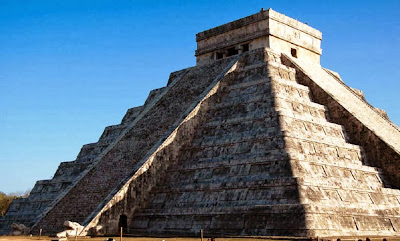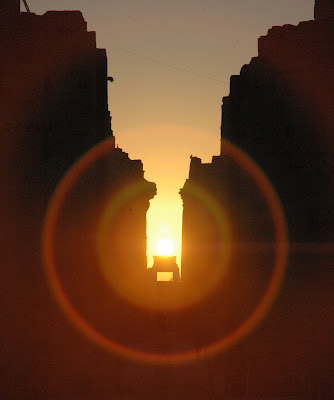Celestial phenomena form the basis for most cardinal and ordinal directional systems and the same was true anciently.
Fact #1. In temperate and tropical latitudes (south of the Arctic Circle, north of the Antarctic Circle), the sun rises in the east and sets in the west. On a flat horizon, sunrise will be due east and sunset due west twice a year, on the vernal equinox (near March 21) and the autumnal equinox (near September 21). The site of Dzibilchaltun in Yucatan is justifiably famous with tourists partly because of spectacular site alignments on equinox sunrise.
![]() |
| Equinox sunrise, Dzibilchaltun |
This is the same structure on vernal equinox about 30 minutes after sunrise.
![]() |
| Equinox sunrise + 30, Dzibilchaltun near Merida |
Even more renowned among tourists is the serpent of light that appears on the steps of the Temple of Kukulcan (El Castillo) at Chichen Itza on the afternoon of each equinox.
![]() |
| Serpent image created by the equinoctial afternoon sun |
Fact #2. The earth's spin axis is tilted 23.5 degrees from the plane of the ecliptic, the hypothetical plane that intersects both the earth and the sun. This tilt causes the seasons as days lengthen toward summer solstice (near June 21) and shorten toward winter solstice (near December 21).
![]() |
| Visual representation of earth's tilted axis |
At the equator on a flat horizon, the sun will rise on the summer solstice at a point 23.5 degrees north of due east. On the winter solstice that point will be 23.5 degrees south of due east. So, at the equator throughout one solar year, the sunrise point will vary across 47 degrees of a 360 degree arc, with that variation centered on due east. As one moves north or south of the equator, variation in solstitial sunrise points increases according to the formula 23.5/cosign(latitude). So, for example, the solstitial variation between sunrise points at Guatemala City (15.5 degrees north latitude) is 48.76 degrees on a flat horizon, slightly more than at the equator. The solstitial variation between sunrise points at Mexico City (19 degrees north latitude) is 49.68 degrees on a flat horizon. Mexico City (Teotihuacan) is about the northern extreme of New World locations that could plausibly be referenced in the Book of Mormon text. So, when the Nephites observed sunrise or sunset, they were looking at points on the horizon within 24.84 degrees of due east or due west. As with the equinoxes, solstice sunrise points were important in ancient architectural layouts. This, for example, is the entrance to the famous Temple of Karnak in Egypt on the winter solstice sunrise.
![]() |
| Entryway, Temple of Karnak, Winter Solstice |
Fact #3. The earth's rotational axis slowly changes orientation, moving in a circle that requires about 25,770 years to complete. This phenomenon, called axial precession, is illustrated in the graphic below.
![]() |
| Earth's Precession |
Because of the earth's rotation, the sky at night seems to wheel in a huge circle around the pole star. This time lapsed image captures the essence of apparent star motion, noted by ancient sky watchers around the globe.
![]() |
| Stars in apparent rotation around the pole star |
Today, the pole star in the northern hemisphere is Polaris, commonly called the north star. Because of the earth's axial precession, the faint star Gamma Cephei will replace Polaris as the pole star about 1,000 years from now. In 2,000 B.C., the pole star was the faint star Thuban in the constellation Draco. This chart shows the way the pole star changes through the 25,770 years of earth's axial precession cycle.
![]() |
| Precession Polar Star Chart |
Sometimes in past ages the celestial pole was simply a void with no visible star at the center of the wheel. Nonetheless, ancient mariners and astronomers oriented to this pole as an unerring indicator of true north at right angles with the eastern sunrise and western sunset.
These celestial phenomena gave rise to systems of cardinal directionality broadly similar to the one we use today. Biblical authors, for example, called their cardinal points zaphon, negev, kedem and yam, words derived largely from their Levantine geography.
![]() |
| Biblical Cardinal Directions |
The association of east with sunrise is well attested in the Biblical text.
Numbers 2:3,
Joshua 12:1,
Isaiah 45:6,
Isaiah 59:19,
Ezekiel 8:16,
In the New World scribal tradition, east was also the direction of sunrise. See "The Defeat of Cabracan" phrases 4, 14 in
Popol Vuh Electronic Library, Allen J. Christenson translator and editor, Provo, UT: Brigham Young University, 2007. See the blog article "
Water Fight on the River - Round Ten" for a number of other indications the ancient Mesoamericans knew and used an astral-based system of cardinal directionality similar to our own.
The Aztec Calendar Stone served many purposes and illustrated many cosmological, chronological and geographic concepts among the ancient Nahuatl of central Mexico. Among other things, the Aztec Calendar Stone was a classic compass rose, dividing space into equal quadrants centered on the cardinal points we know today as north, south, east and west with ordinal points NE, SE, SW and NW.
![]() |
| Aztec Calendar Stone, National Museum of Anthropology, Mexico City |
We commissioned Mexican graphics artist Fernando Vazquez to create a compass rose based on the Aztec Calendar Stone with cardinal, ordinal and intermediate points indicated. We will use this graphic to help us keep everything straight as we wander through the Book of Mormon text examining all occurrences of the words "north,""south,""east," and "west" with variants.
![]() |
| Aztec Calendar Stone as Compass Rose |










